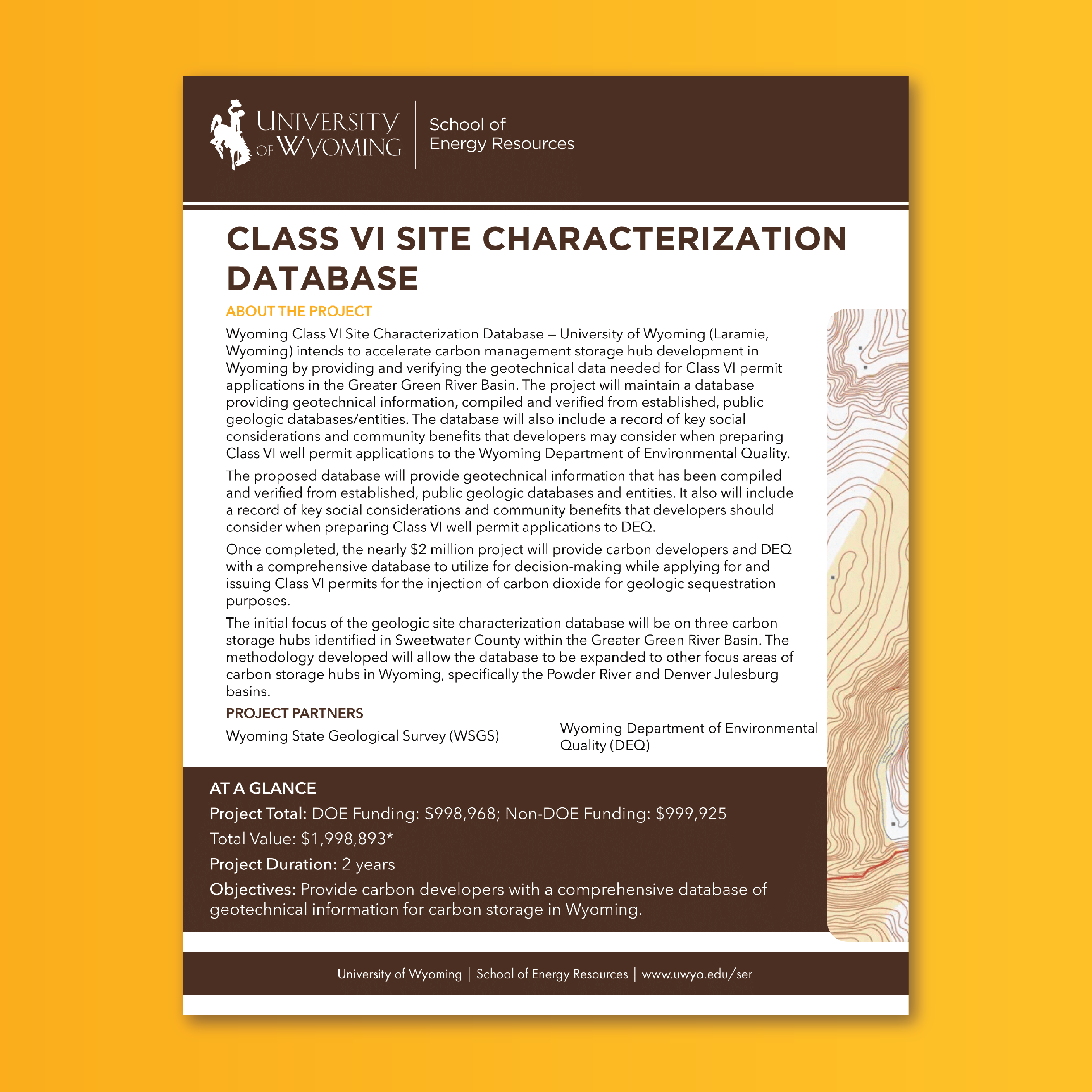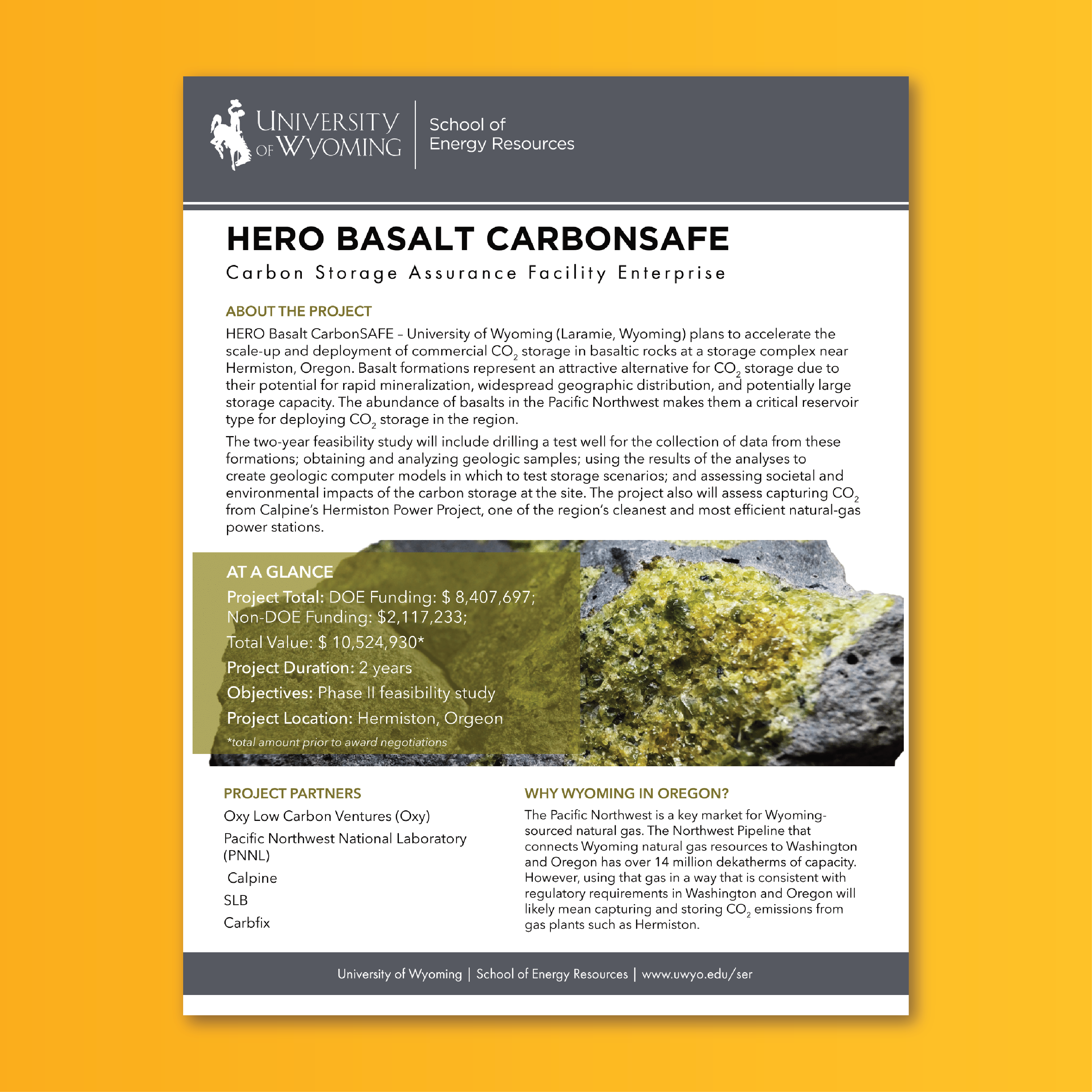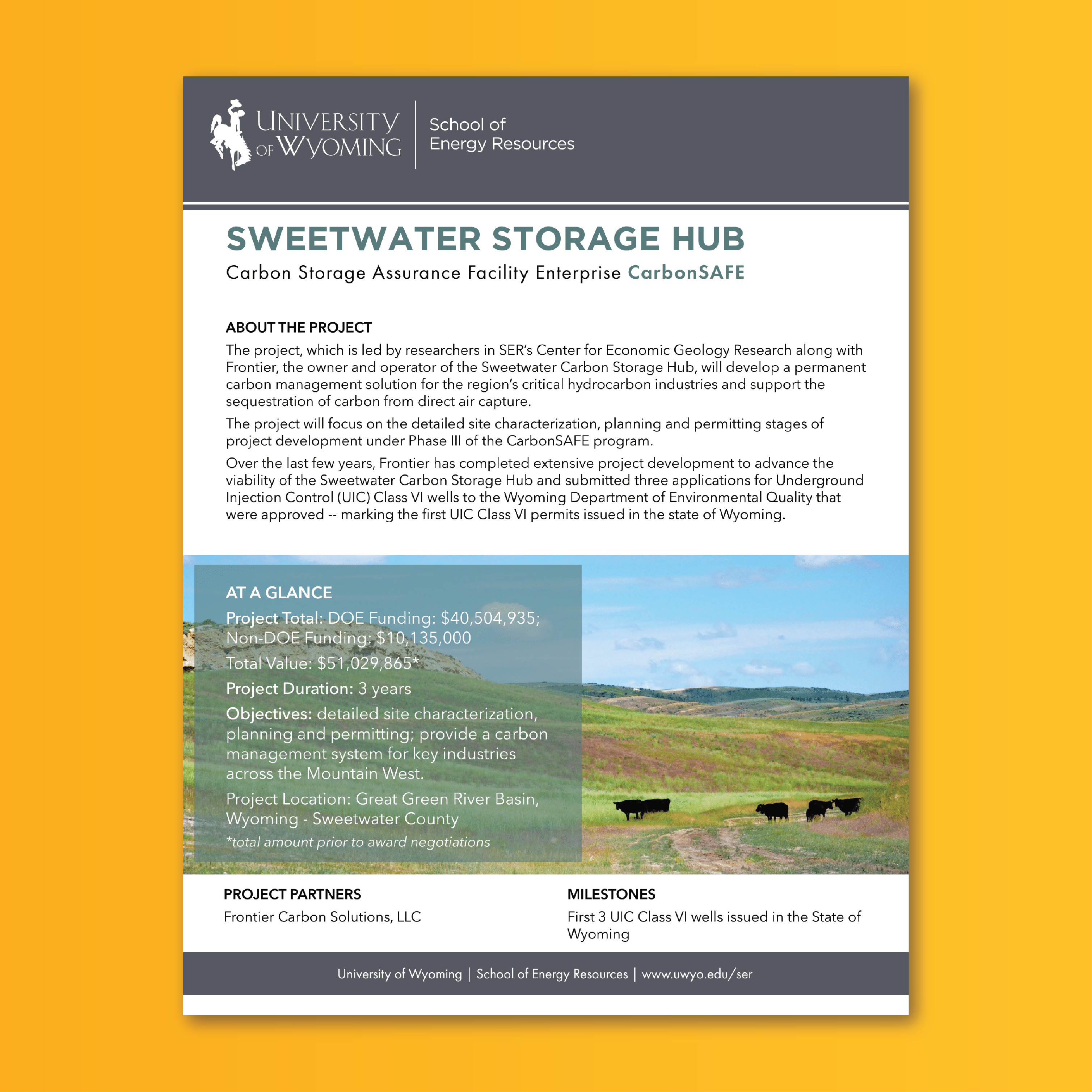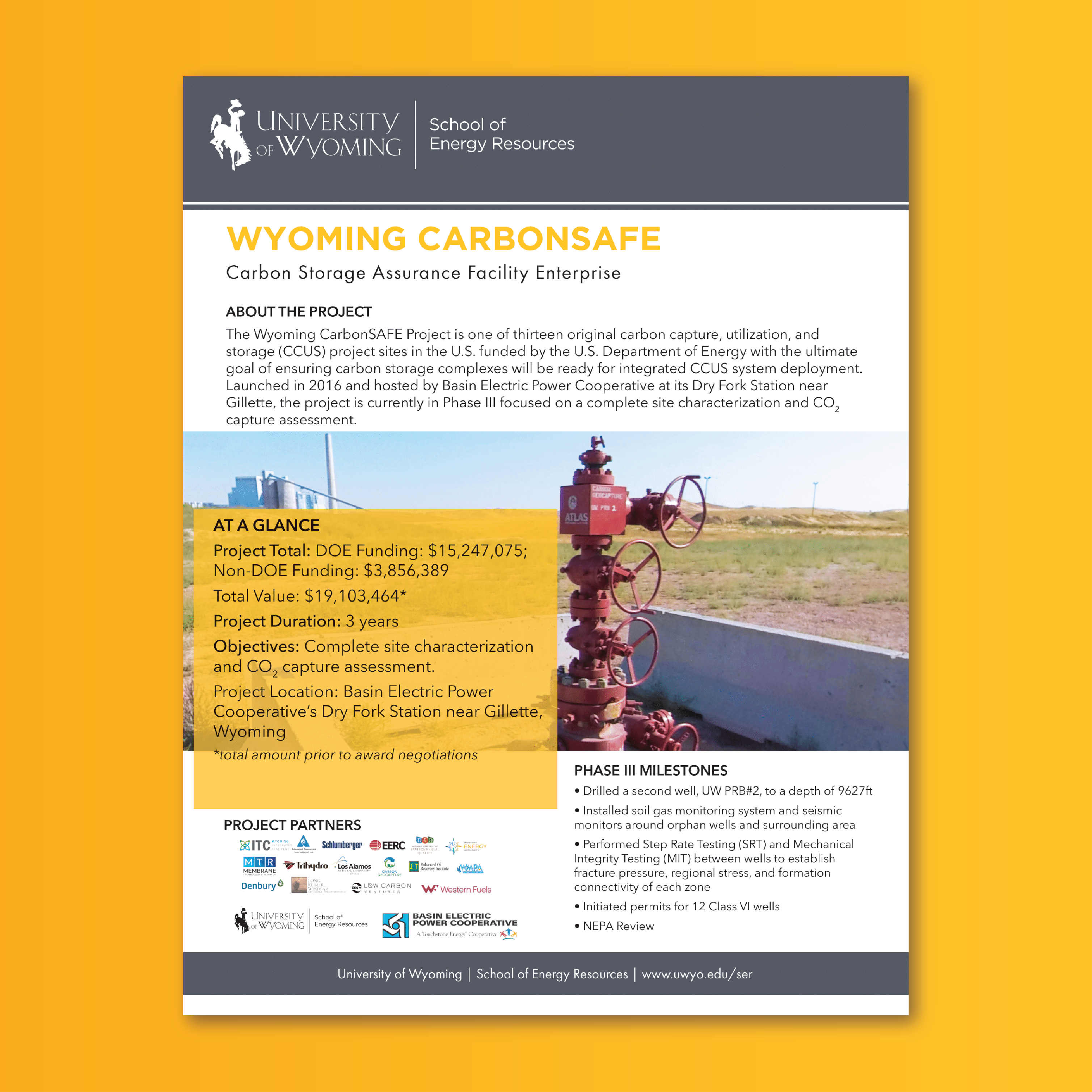Carbon Capture, Utilization, and Storage
Wyoming CarbonSAFE
The Wyoming CarbonSAFE Project, which stands for Carbon Storage Assurance Facility Enterprise, is one of thirteen original carbon capture, utilization, and storage (CCUS) project sites in the U.S. funded by the DOE with the ultimate goal of ensuring carbon storage complexes will be ready for integrated CCUS system deployment. With the advancement of each stage and varying success, fewer sites continued to the subsequent stages. The Wyoming CarbonSAFE project in the Powder River Basin near Gillette, Wyoming is currently in Phase III of the multi-phase project.
PROJECT PHASESWilliams Echo Springs CarbonSAFE
The Williams Echo Springs CarbonSAFE project aims to conduct a storage complex feasibility study to develop a saline carbon dioxide (CO2) storage hub for current and future industries in the Echo Springs area of south-central Wyoming. To be conducted in collaboration with midstream natural gas company Williams, the two-year study plans to permit and drill a deep stratigraphic test well and interpret the resulting data, models and documents for further site development.
HERO Basalt CarbonSAFE
The HERO Basalt CarbonSAFE plans to accelerate the scale-up and deployment of commercial CO2 storage in basaltic rocks at a storage complex near Hermiston, Oregon. Basalt formations represent an attractive alternative for CO2 storage due to their potential for rapid mineralization, widespread geographic distribution, and potentially large storage capacity.
Sweetwater Carbon Storage Hub
The project, which is led by researchers in SER’s Center for Economic Geology Research along with Frontier, the owner and operator of the Sweetwater Carbon Storage Hub, will develop a permanent carbon management solution for the region’s critical hydrocarbon industries and support the sequestration of carbon from direct air capture.The project will focus on the detailed site characterization, planning and permitting stages of project development under Phase III of the CarbonSAFE program.
Consolidated Database Projects
Class VI Site Characterization Database
The Wyoming Class VI Site Characterization Database intends to accelerate carbon management storage hub development in Wyoming by providing and verifying the geotechnical data needed for Class VI permit applications in the Greater Green River Basin. The project will maintain a database providing geotechnical information, compiled and verified from established, public geologic databases/entities. The database will also include a record of key social considerations and community benefits that developers may consider when preparing Class VI well permit applications to the Wyoming Department of Environmental Quality.
Wyoming Technical Assistance Collaboration for Carbon Management
The Wyoming Technical Assistance Collaboration for Carbon Management (WYTAC-CM) project intends to build a comprehensive and intuitive central data repository of technical and nontechnical information to accelerate development of carbon storage projects in the Greater Green River Basin and Wind River Basin.
Rare Earth Elements and Critical Minerals
Rare Earth Element TCF Project
An NETL collaboration with the School of Energy Resources to develop technologies and methods for extracting rare earth elements (REEs) from coal ash funded from the U.S. Department of Energy’s Technology Commercialization Fund (TCF) is working toward a pilot-scale production facility. Located at the Wyoming Innovation Center near Gillette, Wyo., the pilot plant will scale up the extraction technologies previously developed in the laboratory by NETL, and will work to demonstrate the economically viable production of REEs from coal-related feedstocks.
Carbon Ore, Rare Earth and Critical Mineral (CORE-CM) - Powder River Basin
The recently completed Phase I project brought together a committed team of project partners and stakeholders from across the Powder River Basin. The project aimed to maximize development potential of carbon ore, rare earth element, and critical mineral resources while leveraging the highly trained workforce, existing coal technologies, energy infrastructure, and wide public acceptance of energy technology in the basin.
Carbon Ore, Rare Earth and Critical Mineral (CORE-CM) - Greater Green River and Wind River Basins
The recently completed project addressed the upstream and midstream critical minerals (CM) supply chain and downstream manufacturing of high-value, nonfuel, carbon-based products (CBP), to accelerate the realization of full potential for carbon ores and critical minerals within the Greater Green River Basin. The project also aimed to catalyze regional economic growth and job creation by realizing the full potential value of natural resources, such as coal, across basins throughout the U.S.
Great Plains and Interior Highlands CORE-CM
The SER team will lead a regional coalition expanding a domestic critical mineral and materials supply. The project will assess the carbon ore, rare earth and critical mineral (CORE-CM) potential of the Great Plains and Interior Highlands, which is composed of 10 states and four basins first studied under Phase I of the Department of Energy's initiative.
Oil and Gas
The Mowry Project
With a mission focused on driving energy-related economic development within the state, the School of Energy Resources aims to diminish uncertainties and enhance production in Wyoming. The Mowry Shale in the Powder River Basin of Wyoming contains up to 300 million barrels of oil and 2.6 trillion cubic feet of gas. That vast potential remains relatively unexplored due to several issues that include, among other things, the depth of the formation, drilling and stimulation issues due to geomechanical complexity, and the lack of Mowry-specific economic models to assist in forecasting.
PROJECT PAGECEGR Info Handouts

 This project will accelerate carbon management storage hub development in Wyoming
by providing and verifying the geotechnical data needed for Class VI permit applications
in the Greater Green River Basin.
This project will accelerate carbon management storage hub development in Wyoming
by providing and verifying the geotechnical data needed for Class VI permit applications
in the Greater Green River Basin.
 Williams Echo Springs CarbonSAFE project aims to conduct a storage complex feasibility
study to develop a saline carbon dioxide (CO2) storage hub for current and future
industries in the Echo Springs area of south-central Wyoming.
Williams Echo Springs CarbonSAFE project aims to conduct a storage complex feasibility
study to develop a saline carbon dioxide (CO2) storage hub for current and future
industries in the Echo Springs area of south-central Wyoming.
 The University of Wyoming plans to accelerate the scale-up and deployment of commercial
CO2 storage in basaltic rocks at a storage complex near Hermiston, Oregon.
The University of Wyoming plans to accelerate the scale-up and deployment of commercial
CO2 storage in basaltic rocks at a storage complex near Hermiston, Oregon.
The abundance of basalts in the Pacific Northwest makes them a critical reservoir type for deploying CO2 storage in the region.
 The project, which is led by researchers in SER’s Center for Economic Geology Research
along with Frontier, the owner and operator of the Sweetwater Carbon Storage Hub,
will develop a permanent carbon management solution for the region’s critical hydrocarbon
industries and support the sequestration of carbon from direct air capture.
The project, which is led by researchers in SER’s Center for Economic Geology Research
along with Frontier, the owner and operator of the Sweetwater Carbon Storage Hub,
will develop a permanent carbon management solution for the region’s critical hydrocarbon
industries and support the sequestration of carbon from direct air capture.
 The Wyoming CarbonSAFE Project is one of thirteen original carbon capture, utilization,
and storage (CCUS) project sites in the U.S. funded by the U.S. Department of Energy
with the ultimate goal of ensuring carbon storage complexes will be ready for integrated
CCUS system deployment.
The Wyoming CarbonSAFE Project is one of thirteen original carbon capture, utilization,
and storage (CCUS) project sites in the U.S. funded by the U.S. Department of Energy
with the ultimate goal of ensuring carbon storage complexes will be ready for integrated
CCUS system deployment.

